Most people know that knives come with different blade lengths and styles, but only a few realize there is also variation in the type of material used to design the blade. The material of the blade is not only what determines its sharpness, but it also affects the knife’s flexibility and durability. As a result, knowing which material will work best for the desired purpose is necessary.
Chefs, knife enthusiasts, and knife manufacturers consider high carbon stainless steel as the best material for kitchen knives. High carbon stainless steel comes with the perfect blend of rust resistance, flexibility, hardness, and tensile strength that help foster edge retention on kitchen knives. Other materials such as carbon steel, stainless steel, ceramic, and Damascus steel are also good choices, depending on your needs and budget.
This article will discuss further the different materials for kitchen knives, their pros, cons, and uses. It will also discuss the best knife handle materials to help you know more about your current knives and your next one.
Table of contents
What makes a good material for a kitchen knife blade?
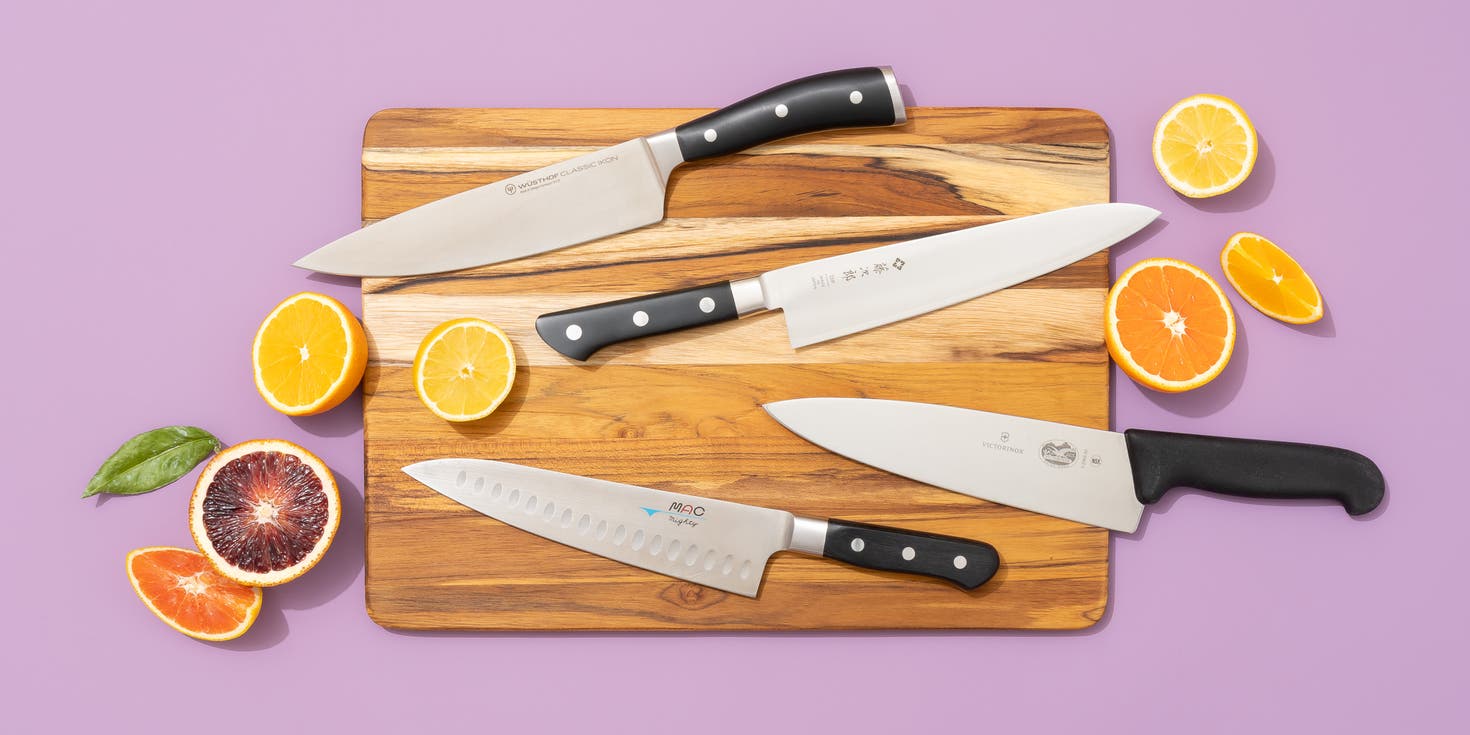
Certain features determine when a material is suitable for use in making kitchen knives. The properties of the knife blade are rooted in its material’s composition and how it was manufactured.
In general, a material that is resistant to rust and corrosion while at the same time tough, flexible, and hard enough to hold an edge well is considered a good choice for a knife blade.
It’s important to note that while a knife can hold a sharp edge, the material’s resistance to wear determines how long the blade will keep its sharpness. Notably, using the knife on hard surfaces or cutting through thick objects will diminish its sharpness faster.
Alloys that are strong, hard, and tough will hold an edge for a longer time than soft ones. In addition, certain knife blade materials become less flexible when they get too hard. Materials with a high carbon content make the hardest knives with long lasting blades.
Types of kitchen knife blade materials
There are four primary kitchen knife blade materials:
- Stainless steel
- Carbon steel
- Damascus steel
- Ceramic
Stainless steel
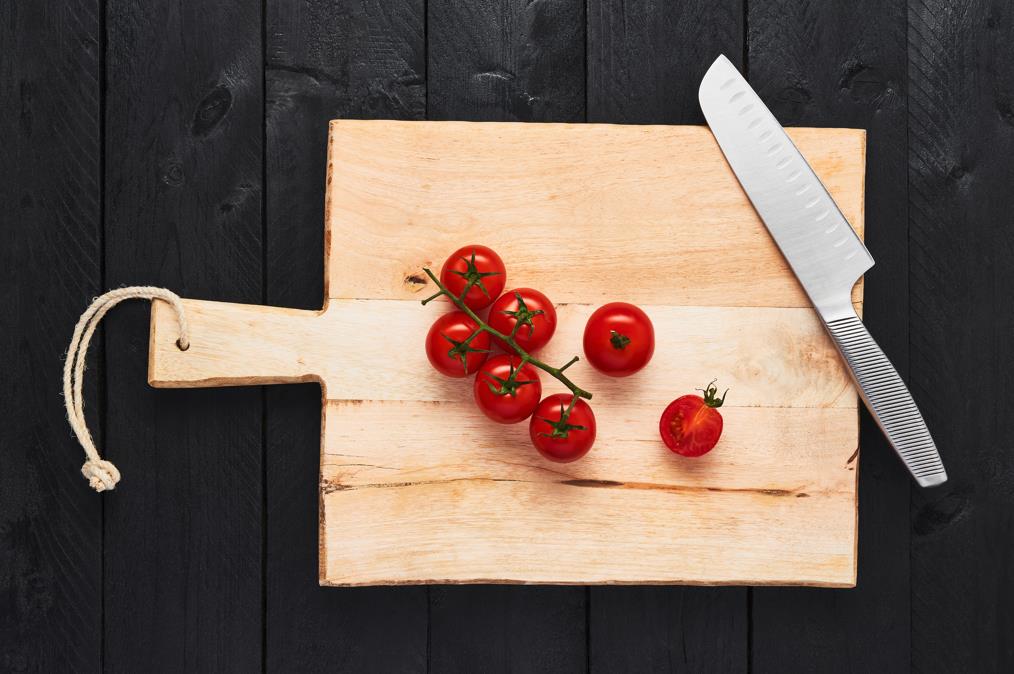
Stainless steel is one of the most popular kitchen knife blade materials. It’s tough, rust-resistant, and has an excellent strength-to-weight ratio. In a basic sense, steel is an alloy of iron and carbon. However, stainless steel contains about 10.5% chromium, giving it rust resistance.
Most home kitchens use stainless steel knives because they are cheaper than other materials, are robust, long-lasting, and require less maintenance. To ensure your stainless steel knife lasts long enough, make sure to wash it by hand using a mild detergent, dry it immediately, and store in a knife block or on magnetic strips.
Pros of stainless steel
- Less prone to rusting and corrosion than other knife blade materials
- Does not easily chip, flake, or roll
- Hygienic
- Long term value
- It’s relatively cheaper than other knife blade materials
Cons of stainless steel
- It does not hold an edge or maintain sharpness for long
Carbon steel
The use of carbon steel dates back to the early days of knife making. Plain carbon steel is a combination of iron and carbon. However, other elements such as manganese, copper, and silicon are also added during the kitchen knife manufacturing process.
The main difference between carbon steel and stainless steel is that stainless steel has chromium (at least 10.5 percent). However, carbon steel stays sharp longer than stainless steel. If you want a knife with incredible sharpness, look no further than carbon steel kitchen knives.
Pros of carbon steel
- Sharper than stainless steel
- It’s harder
- More straightforward to sharpen than other knife materials
Cons of carbon steel
- Slightly more expensive
- Rusts and corrodes way faster than stainless steel
- Carbon steel reacts with some foods such as onions and tomatoes and can alter their taste.
Handpicked for you
True cutting power in the palm of your hand
Damascus steel
Damascus steel was popular during the Middle Ages because of its strength and flexibility. It’s composite steel with high carbon content, featuring three to five different types of alloying elements. We can say nowadays it’s a process rather than a material because a blacksmith would fold, pound, and manipulate alloying materials to create intricate designs, patterns, and formations.
About 1.3 to 1.8 percent of a Damascus kitchen knife is carbon content. Damascus steel comprises soft steel sandwiched between layers of hard steel, which are then forge-welded together, creating distinctive patterns on the blade. The hard outer steel is responsible for the sharp edge.
It’s important to note that some poor quality Damascus knives only focus on the appearance, patterns, and designs but forego quality and strength. Wash and dry your Damascus steel after every use to prevent rusting and corrosion. You can also use cooking or mineral oil to prevent rusting.
Pros of Damascus steel
- Superior toughness
- Designed for excellent edge sharpness and edge retention
- Beautiful patterns
- Durable
Cons of Damascus steel
- More expensive than stainless steel, carbon steel, and other knife materials
- Requires regular oiling and cleaning to prevent rusting and corrosion
Ceramic
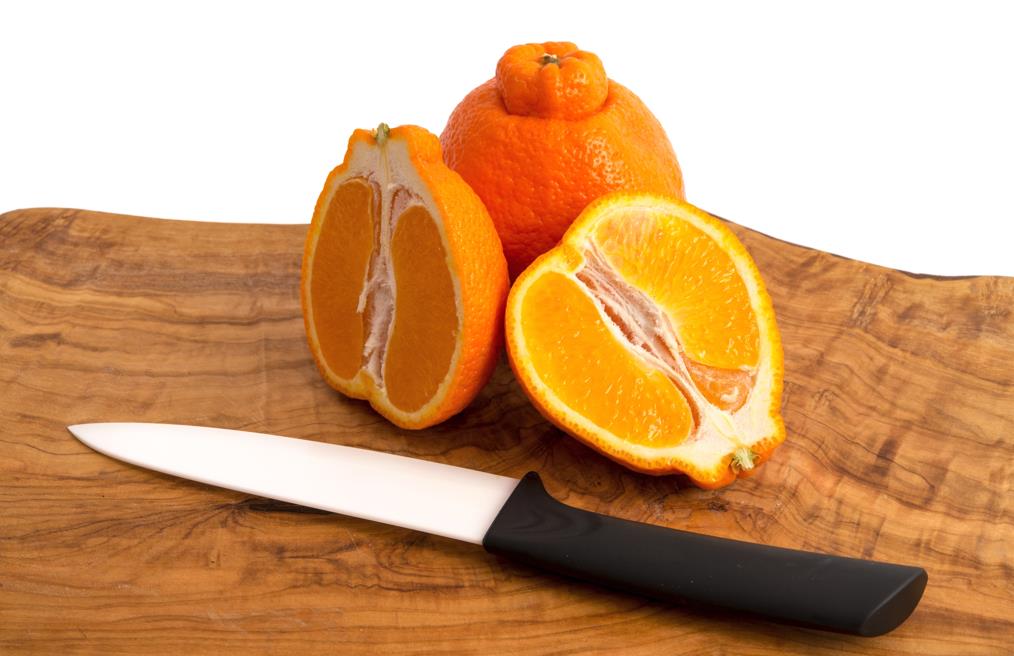
The ceramic material is an excellent option for your kitchen knives if you want an incredibly sharp blade that does not rust. Ceramic material makes for lightweight knives with a super-sharp edge. Ceramic knives comprise extremely hard zirconium dioxide or, better still, zirconia.
Manufacturers dry press and fire the zirconia at extremely high temperatures to make ceramic knives, resulting in a tough and brittle material. The knife’s edges are then sharpened using diamond or silicon carbide wheels and coated with diamond powder to make the blade razor-sharp.
Although ceramic knives aren’t as popular as carbon knives, they are gaining steady popularity amongst chefs and knife enthusiasts. One notable benefit is that the ceramic material makes the knife extra sharp and easy to maintain. The lightweight nature and attractive appearance of ceramic knives make them ideal for any individual.
Pros of ceramic knives
- Extraordinarily sharp and adept at maintaining their sharpness
- Lightweight and easy to handle and use
- Non-reactive with acidic foods
- Resist rust and corrosion
Cons of ceramic knives
- They are brittle and may break
- Difficult to sharpen
- Can not be used to cut bones, carcasses, or any other hard ingredients.
Types of kitchen knife handle materials
It’s important to note that a knife handle material has a significant impact on the blade itself.
There are three significant categories of kitchen knife handle materials:
- Natural handle
- Metal handle
- Synthetic handle
Natural knife handle materials
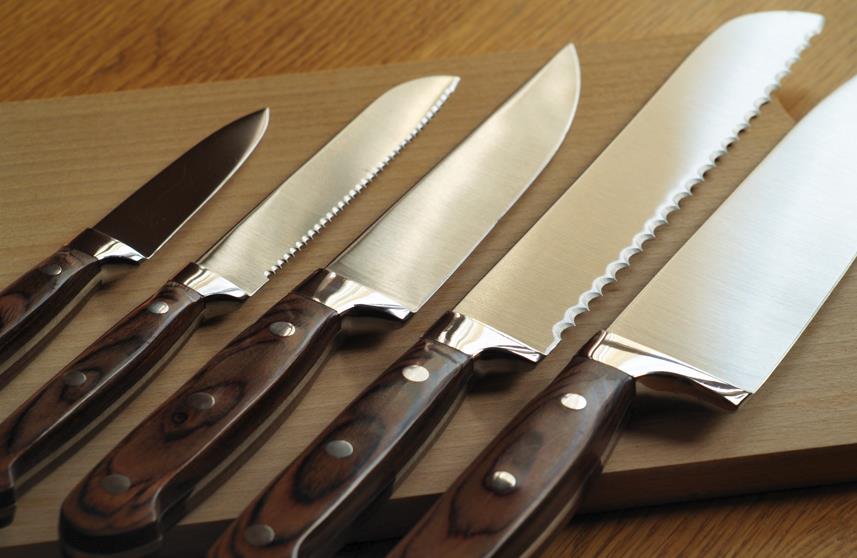
Natural materials make for attractive and well-performing knife handles. Although you can find natural kitchen knives in any material, the most popular kitchen knives use wood or bone. Others feature mother of pearl, water buffalo horn, or jade.
Wood handles
Wood handles are the most common natural kitchen knife handle material. Wood makes for a comfortable and reliable handle with exceptional durability and a beautiful appearance. Natural wood features a variety of colors and patterns that give it a unique and attractive look.
Natural wood handles can be expensive or cheap depending on the type of wood used and the design involved, but you should look for knives with wooden handles designed with a high-quality finish for exceptional results. Wood is porous and absorbs moisture, making it susceptible to damage if exposed to moisture or water for long periods.
For wood handles to last longer, proper treatment with oils is necessary. Select manufacturers will inject resin into the handle or apply a wood filler to enhance its durability. However, the process is expensive and not so common to wood handles.
Bone/horn handles
Bone and horn handles feature a lot of decorative patterns, making them a popular choice for knife enthusiasts. Although they are less common than wood, bone and horn create beautiful knives.
They provide a traditional yet durable and attractive finish that adds to the durability of the knife. Bone and horn materials are also porous and susceptible to damage if exposed to extreme conditions. While some people would love the natural feel of the bone or horn, others will apply resin and linseed oil to create a more appealing appearance.
Mother of pearl
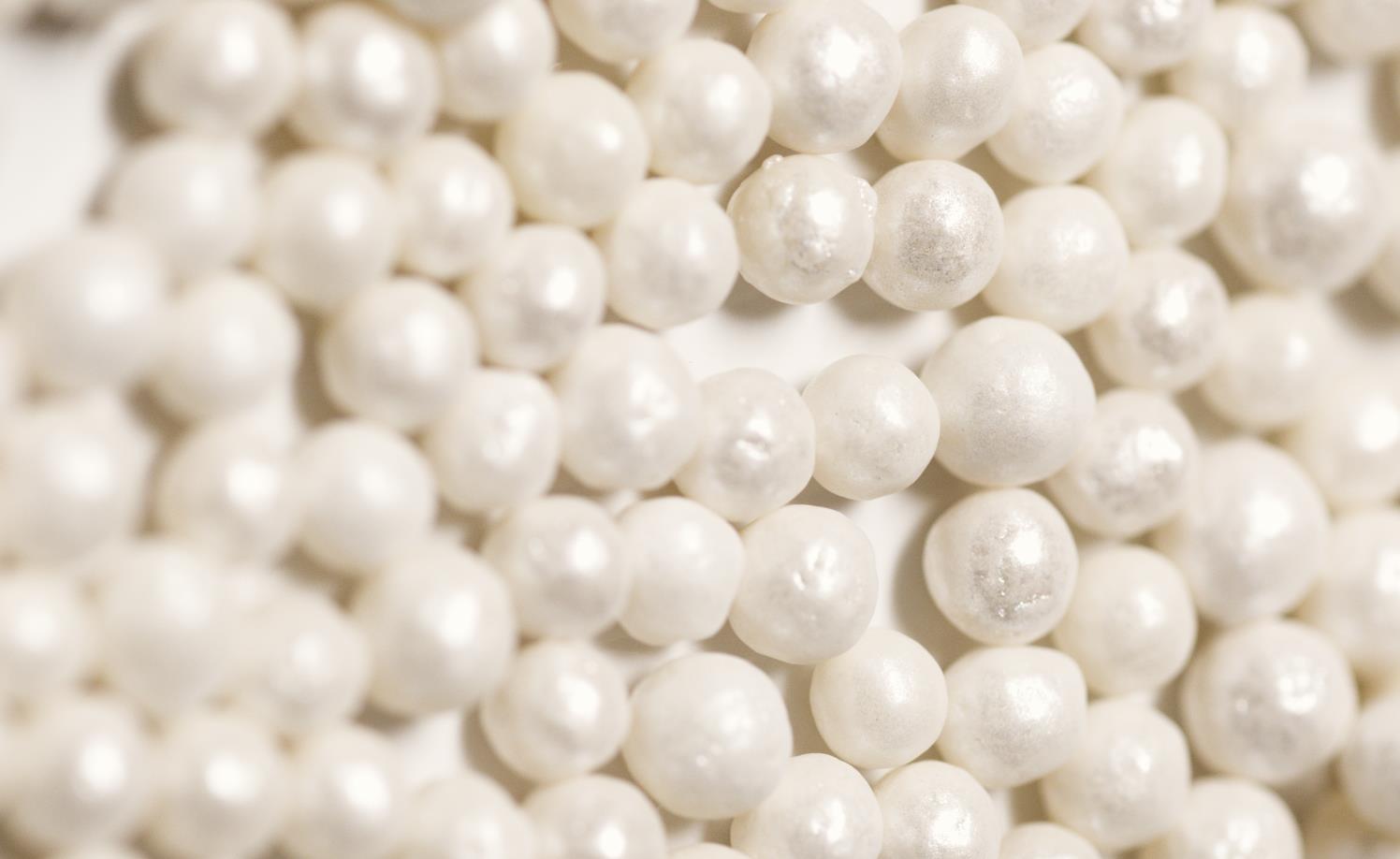
To something beautiful, mother of pearl handles are also durable. They have an exceptional appearance that results in beautiful knife designs with unique patterns. The mother of pearl comprises a calcium carbonate base primarily from oysters and mollusks.
Manufacturers fabricate the mother of pearl handles by fusing multiple layers of natural material. These layers create a smooth and durable handle that is also attractive and well-performing. Due to their unique nature, they are a bit expensive.
Pros of a natural knife handle
- Attractive appearance and patterns
- Durable and comfortable to use
- Feel natural to the touch
- Cheaper than most handle materials
- Readily available
Cons of natural knife handle materials
- They are porous and susceptible to heat and water damage if exposed for long periods.
- Some unique handles are expensive
- Not all will feature a high-quality finish
Metal knife handles
Metal knife handles come in various materials, including stainless steel, aluminum alloy, titanium, copper, nickel alloy, and cast iron.
Stainless steel knife handles
Stainless steel offers a durable and comfortable knife handle that’s popular among manufacturers. Most will design a metal insert for the blade to rest. In addition, stainless steel offers the most specific weight, an essential factor in knife design.
For stainless steel to retain its beauty and quality, manufacturers will apply different finishes to it. They range from matte to shiny polished finishes that give each knife a unique appearance. Stainless steel is slippery, so choosing one with a non-slip handle for comfort and stability is essential.
Aluminum alloy knife handles
Manufacturers create aluminum alloy knife handles by mixing aluminum with zinc, magnesium, and other metals to enhance durability. Like stainless steel, they come in various finishes such as polished, matte, or painted, giving each knife a unique appearance. They are also lightweight and easy to maintain.
Due to its popularity, manufacturers create aluminum alloy handles that mimic the appearance of other materials like wood. They are durable, comfortable, and inexpensive. However, they can be cold to the touch and a bit slippery.
Titanium knife handles
Titanium knife handles are high-performance materials that offer exceptional strength and durability. Like stainless steel, they come in various polished finishes to give each knife a unique appearance. While titanium is more expensive than other metals, it requires less maintenance, making it an excellent choice for kitchen knives.
Pros of a metal knife handle
- They are durable and comfortable.
- All metal knife handles offer a specific weight, which is an essential factor in knife design.
- Multiple finishes and designs to choose from for customization purposes
- They are strong and easy to maintain
- Resistant to rust
Cons of a metal knife handle
- They are slippery
- Some of these materials can be more expensive than others
- Not all will have a non-slip handle
Synthetic knife handle material
Manufacturers create synthetic knife handles by mixing polymers with other materials like rubber, wood, and metal. Like other materials, manufacturers offer different designs to make each knife unique. You can find them from exotic to simple designs that will work with any kitchen decor.
Carbon fiber
Carbon fiber is a lightweight material that offers superior strength, exceptional durability, and is corrosion resistant. It’s also known as graphite fiber and results from combining multiple layers of organic polymers with other elements like plastic resin.
Carbon fiber gives off a strong and distinct look that is an excellent choice for kitchen knives. Its lightweight nature provides a sturdy grip and easy handling.
Micarta
Micarta is a brand name of a synthetic resin and linen material. Manufacturers use different combinations of materials, such as fiberglass and polyphenylene sulfide or petroleum-based resins, to create micarta. It’s durable, will never crack, and is extremely lightweight for easy handling.
Micarta also comes in various designs that add personality to any kitchen. It’s a smooth and slippery texture, but it is easily cleaned with warm water and dish soap. Despite being pricey, it will last longer than most materials on the market.
G-10
G-10 is a high-density material composed of glass and fiber. Manufacturers heat layers of fiberglass with resin to create G-10, which ensures its unmatched durability. It’s also tough, strong, and lightweight, which provides impressive performance for chefs.
Manufacturers add texture to the material by checkering, which gives chefs a secure grip on their knives. It is non-porous, making it hygienic and easy to clean.
Pros of a synthetic knife handle
- They are easy to clean
- Lightweight for easy handling
- Manufacturers make them in different colors, textures, and designs to personalize each knife.
- They are durable, sturdy, and strong
Cons of a synthetic knife handle
- Some materials might be slippery when wet or greasy foods get on the handle.
- They can be more pricey than other materials.
- Synthetic materials might be more challenging to maintain than wood or natural handles.
What kind of material should you choose for your knife?
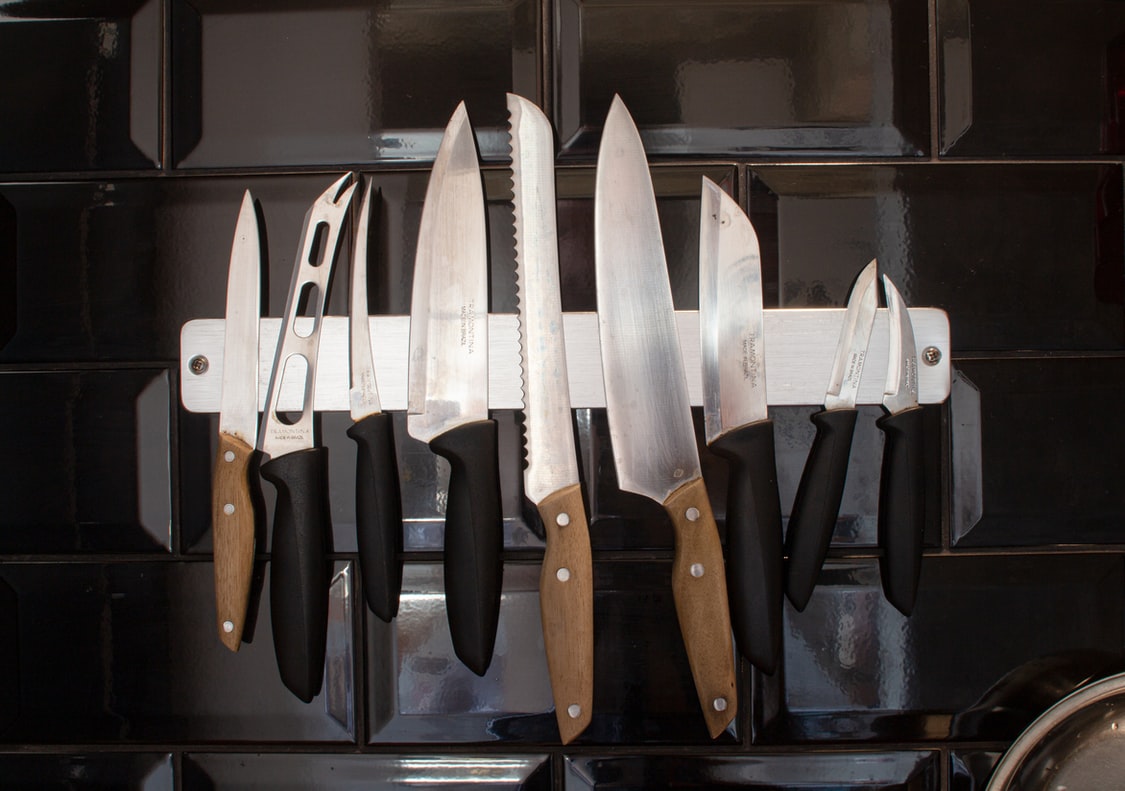
When choosing a knife handle or blade material, it’s essential to consider a few factors. Do you want a simple design that will complement your kitchen decor, or do you want something more colorful? What type of food do you plan to use your knives for? Will the material be easy to clean and maintain?
When looking at stainless steel blades and knife handles, chefs need to consider the comfort and durability of the material. Stainless steel is easy to clean, maintain, sturdy, and strong for daily use. While it might be slightly slippery when wet or greasy food gets on the handle, this material will last longer than most materials on the market.
Ceramic materials are fragile, and a knife made from this material needs to be handled carefully. While it might not be ideal for heavy use, ceramic knives are sleek, stylish and come in different designs with personalized colors.
Carbon steel blades offer superior hardness and long lasting sharpness. However, high carbon content makes the knife less flexible and brittle.
For handles, go for materials with texture for a better grip, such as wood. A good handle should be lightweight and easy to maneuver through food but sturdy enough for heavy use. Ideally, the material should be heat-safe and clean easily.
Closing
The best material for kitchen knives is the one that’s lightweight, sturdy, and strong to handle daily use. It should also be easy to clean with colors or designs to personalize your knives. It would be best to conduct extensive research before buying kitchen knives to find out which material best suits you.
Check out our store for superior quality knives with high carbon steel blades and quality wooden handles.












